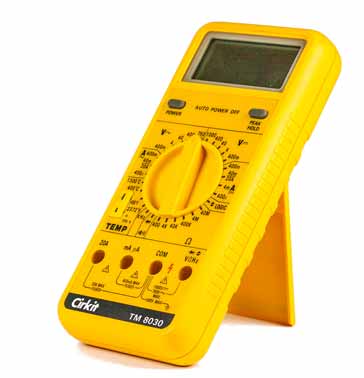Understanding Digital Multimeter DMM Accuracy, Resolution & Counts
Understand the difference between digital multimeter, DMM accuracy & resolution and how they are measured including the 'counts' specified for the resolution.
Multimeter Tutorial Includes:
Test meter basics
Analogue multimeter
How does an analogue multimeter work
DMM digital multimeter
How a DMM works
DMM accuracy & resolution
DMM CAT ratings
How to buy best digital multimeter
Cheap vs expensive DMM
How to use a multimeter
Voltage measurement
Current measurements
Resistance measurements
Diode & transistor test
Fault finding transistor circuits
Analogue vs Digital multimeter
Test leads & probes
The overall accuracy of a digital multimeter is key to its use. Knowing its accuracy will enable readings to be interpreted in the right manner.
Two figures are often quoted and although linked, their exact meanings can sometimes be confused.
Fortunately for many applications, the accuracy, and the resolution of a digital multimeter is well beyond what is needed, but for those instances where it is required, a good understanding is very useful.

A digital multimeter has two main constituents that are related to accuracy which are often confused:
- DMM accuracy
- DMM resolution
The accuracy and resolution will be described separately to outline what they are and what the differences are.
Digital multimeter accuracy
The accuracy of the digital multimeter is effectively the uncertainty surrounding the measurement. It is the amount by which the displayed reading can differ from the actual input.
There are a number of ways in which the digital multimeter accuracy may be expressed:
- DMM Accuracy = ±(ppm of reading + ppm of range)
- DMM Accuracy = (% Reading) + (% Range)
- DMM Accuracy = (% Reading) + Offset
Here ppm refers to parts per million.
The way the accuracy is expressed depends upon the exact format for the instrument and also the preferences of the manufacturer. This sometimes makes comparing instruments from different manufacturers more difficult.
To give an example of how this may be calculated for a particular instrument. If 5 volt reading is being made and the specification for the DMM states that for the conditions within the laboratory, the reading will be ± 25ppm, and the 10 volt range is being used for which the accuracy is ± 8ppm.Thus the indicated reading should be within 205µV of the actual value.
Effect of temperature on DMM accuracy
As with many other electronic items, temperature can have a significant effect on the measurement accuracy of a DMM.
Many precision or high accuracy digital multimeters have a temperature coefficient contained within the specification.
Although the way in which they may be expressed can vary occasionally the most common way to express them is as ±(ppm of reading + ppm of range)/°C.
DMM accuracy for AC
It will be found that the level of AC accuracy for the digital multimeter is normally less than that for DC measurements. The AC measurements will also be optimised for 50-60 Hz and this means that other frequencies may have poorer degree of accuracy.
As with DC accuracy specifications, a number of counts (often greater than for DC) will be added to the accuracy percentage. Also, for waveforms other than a pure sine wave, additional inaccuracy will be encountered when measured with an average responding DMM.
Even a true RMS responding DMM will have some accuracy limitations for waveforms with high peak amplitude components if measured near full scale.
Digital multimeter resolution in terms of digits
The resolution of a digital multimeter traditionally was specified in terms of the number of digits displayed. This has now generally been superseded by defining the number of counts it can provide but it is still worth mentioning the number of digits as the system is still used by some people, and it will be quoted on legacy digital multimeters.
Typically this will be a number consisting of an integer and a half, e.g. 3 ½ digits. By convention a half digit can display either a zero or 1.
Thus a four and a half digit meter could display up to 19999. Occasionally a three quarters digit may be used instead of the half. When this is seen, it indicates that the DMM additional numeric can display a number higher than one, but less than nine.
Occasionally other figures like a 4 ⅔ may be seen, and although there is not hard and fast definition of what this is, it is better than a 4 ½ meter. These meters can generally display more than 1999, often going up to 4999, 5999, or more for a 3&frac23 or 3⅔ digit meter.
It is worth remembering that increased levels of resolution do not come without penalties. Longer settling times are required for the far right digits to reach their final value. Thus the time between readings is longer.
Digital multimeter counts
These days it is more common to define the resolution of a digital multimeter in terms of counts. This is a more definitive method of specifying the resolution of the meter.
In essence, the higher the number of counts the test instrument provides the better is the resolution.
Essentially the counts indicates the maximum value that can be displayed. Generally the number of counts is rounded up. A meter with an actual maximum number of counts of 1999 will generally be quoted as a 2000 count meter because it displays 0 - 1999 which is actually 2000.
In practical terms this has an impact on the minimum difference that can be measured by a meter. For example, a 1999-count multimeter can measure down to a tenth of a volt when measuring voltages up to 199.9 volts but when the voltage reaches 200 volts the cannot measure down to a tenth of a volt because it will have exceeded the 1999 counts limit and the display will change to display 0200V as it cannot display 200.1.
Although it depends upon the actual meter, a 3⅔ digit digital multimeters might provide counts of up to 4000 (meaning a max of 3999 on the meter's display). 5000 and even 50000 count meters are also available.
In this way, defining or specifying the number of counts more accurately defines the resolution of the digital multimeter than specifying the number of digits.
Digital to analogue converter resolution
For some digital multimeters the traditional format for quoting the resolution of digits of display may not be appropriate.
This is particularly the case for virtual instruments where the display is software controlled and therefore not a limiting factor. Instead the limiting factor is the analogue to digital converter, ADC.
For these instruments the resolution is often expressed in bits. For example a 14 bit ADC would give 2^14 distinct values, i.e. 16384 values.
It is possible to relate the digits of resolution to the number of the least significant bit.
Where the log is log to the base 10.
This means that for a digital multimeter with a 14 bit ADC the least significant bit is 16384.
When buying a digital multimeter it is necessary to ensure that the accuracy and resolution are sufficient
. . . . Read more about How to Buy the Best DMM.
Digital multimeter accuracy and resolution figures mean that for very many readings the test instrument provides a figure that is far in excess of what may be needed - for fault finding, often the approximate value is fine. However in cases where the actual value is important it is necessary to ensure that both the accuracy and the resolution mean that the DMM reading is sufficiently accurate and also has sufficient resolution.
 Written by Ian Poole .
Written by Ian Poole .
Experienced electronics engineer and author.
More Test Topics:
Data network analyzer
Digital Multimeter
Frequency counter
Oscilloscope
Signal generators
Spectrum analyzer
LCR meter
Dip meter, GDO
Logic analyzer
RF power meter
RF signal generator
Logic probe
PAT testing & testers
Time domain reflectometer
Vector network analyzer
PXI
GPIB
Boundary scan / JTAG
Data acquisition
Return to Test menu . . .



